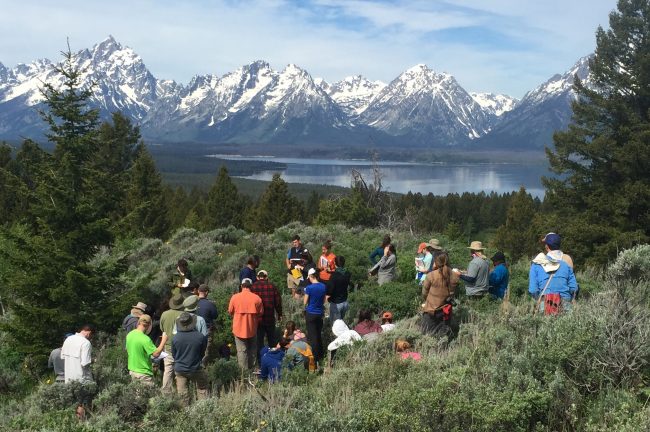University of Texas Geosciences Ranks Among World’s Best
April 6, 2017

The University of Texas at Austin has one of the best geosciences research programs in the world according to two recent global rankings.
The Nature Index of scientific productivity ranked UT Austin No. 4 globally among academic institutions for Earth and environmental Sciences. The Center for World University Rankings, the largest academic ranking of global universities, ranked UT Austin No. 3 globally for geology. Both rankings are based on publication of peer-reviewed research in top-tier journals.
In the most recent ranking of graduate education programs from U.S. News & World Report, UT Austin ranked No. 5 for geology. The combination of rankings underscores the productivity and excellence of UT Austin’s Jackson School of Geosciences, which is the largest geosciences program in the country with nearly 600 undergraduate and graduate students.
“It’s rare to find a school that is the largest in a discipline and also operates at an elite level in both education and research,” said UT Austin President Gregory L. Fenves. “These rankings are a reminder of the global distinction and impact of geosciences at the University of Texas.”
The Jackson School consists of three world-class academic and research units – the Department of Geological Sciences, the Institute for Geophysics and the Bureau of Economic Geology. Combined, these institutions offer a depth and breadth of geosciences matched by few universities. They spearhead research vitally important to Texas, the country and the world.
“Geosciences is about tackling the tough issues affecting the world today, whether they deal with energy, water, natural hazards or the environment,” said Jackson School Dean Sharon Mosher. “These rankings reinforce our ongoing commitment to conducting research that improves the lives of Texans and to provide the highest quality education to help shape the next generation of leaders in the field.”
While renowned globally, the Jackson School’s three units work annually on research projects that benefit all Texans — directly in many regions of the state and indirectly by improving the state’s economy and environment. The map below offers a representative sample of current UT Austin geosciences projects across the state.
1. TexNET/CISR
A statewide seismic monitoring system and research center established and funded by the Legislature and Governor that will help scientists determine what’s causing earthquakes in Texas and how to protect the safety of its citizens.
2. TxSON
A network of ground-based monitors throughout Texas that measures soil moisture to better understand and predict intense droughts and floods.
3. Shale Resource and Reserve Studies
The most comprehensive public study of six major shale plays in the nation—with half in Texas—to understand how much oil and natural gas is in the ground, what will be developed in the future, and at what cost.
The Marine Geology & Geophysics Field Course on the Texas Coast — a one-of-a-kind class that is training the next generation of geophysicists for the future energy industry.
5. GeoFORCE
A program that teaches high school students from underserved areas in Texas about the geosciences and helps prepare them for college and careers. GeoFORCE recently received the Presidential Award for Excellence In Science, Mathematics and Engineering Mentoring, the highest such honor from the United States government.
The State of Texas Advanced Oil and Gas Recovery Program is a state-funded program that assists oil and gas operators using the latest technology, geoscience and engineering understanding to increase production in existing fields and regional exploration projects.
7. Hurricanes and Coastal Erosion
From using state-of-the art lidar techniques to map the Texas coast to the Rapid Response Program, which places scientists at the scene of natural disasters soon after they occur, UT is helping the State understand and prepare for the effects of hurricanes, coastal erosion, floods, and other natural hazards.
A comprehensive study of well water in the Fort Worth area that found methane in the well water most probably came from a natural deposit, not hydraulic fracturing operations.
UT is leading research on the impact that energy production and agriculture have on water use and on how to manage the state’s limited water resources. Other projects include working with the Texas Parks and Wildlife Department to monitor soil moisture along the Brazos River after invasive saltcedar trees are removed.
10. Methane Hydrate
An $80 million Department of Energy funded project to drill for and collect samples of methane hydrate – a potential future energy source – from the shallow subsurface of the Gulf of Mexico and study its behavior and properties.
11. Gulf Basin Depositional Synthesis Program
The GBDS Program builds an ever evolving picture of Gulf of Mexico geology using data from academic and industry partners. The data recently gave companies a first look into previously off-limits waters around Mexico, an area of critical interest and importance to the Texas oil and gas industry.
A high resolution 3D marine imaging technology is giving researchers a better look at Gulf of Mexico subsurface for the potential to store large volumes of carbon dioxide emissions and create a new industry in Texas.
More than 1.5 million boxes of rock core and cuttings are available for study at each of the Bureau of Economic Geology’s three core repositories in Austin, Houston and Midland. The potential of the Eagle Ford Shale—which produces over 800,000 barrels of oil per day—was first realized by Texas geologists studying cuttings held in these repositories.
14. Petra Nova Carbon Monitoring
A first-of-its-kind project led by NRG Energy that directly captures carbon dioxide from a commercial power plant and stores it underground while increasing oil production in the process. Researchers are helping monitor the carbon dioxide to ensure it stays underground.
For more information, contact: Anton Caputo, Jackson School of Geosciences, 512-232-9623; Monica Kortsha, Jackson School of Geosciences, 512-471-2241.

